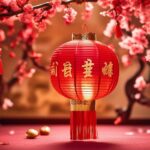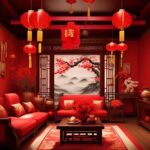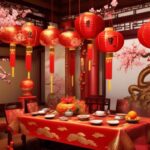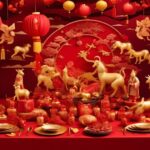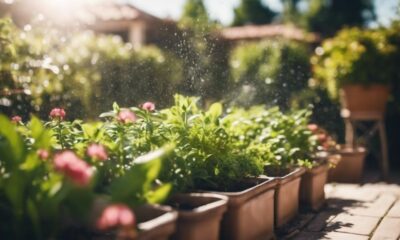Decor
Chinese New Year Accessories Decoration
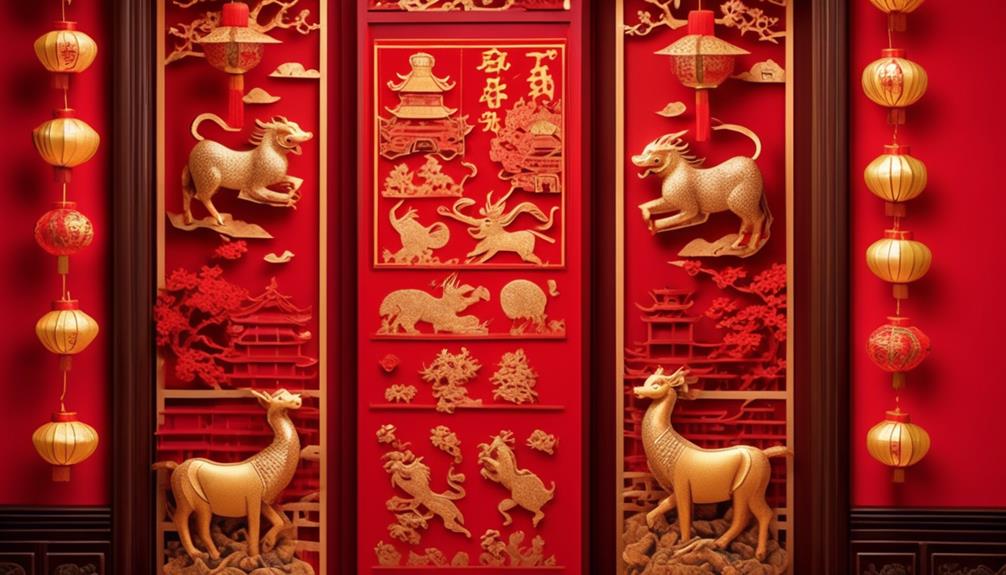
When it comes to decorating with Chinese New Year accessories, we discover a seamless fusion of traditional charm and sophistication.
The adornments for this festive occasion include red lanterns, paper cutouts, lucky symbols, and festive door couplets. These accessories are carefully chosen to bring an auspicious and celebratory atmosphere to homes and public spaces during the Chinese New Year.
From elegant wall scrolls to symbolic zodiac animal figurines, each piece holds deep cultural significance and adds a touch of festivity to the surroundings.
The decorative red envelopes, golden ingot embellishments, and festive table centerpieces complete the ensemble, creating an ambiance of joy and prosperity.
Key Takeaways
- Traditional decorations for Chinese New Year include red lanterns, elegant paper cutouts, symbolic paper designs, festive window decorations, and festive door couplets.
- Lucky symbols and charms are commonly used in Chinese New Year decorations, including traditional door couplets, calligraphy art, symbolism and colors, and auspicious wall scrolls.
- Cultural significance is found in the use of colorful dragon and lion dance props, ornate tassel decorations, symbolic plant meanings, mandarin orange displays, and intricate Fu character art.
- Feng Shui and prosperity are important aspects of Chinese New Year decorations, with emphasis on placement for luck, prosperity blossom plants, mandarin orange displays, intricate Fu character art, and joyful firecracker ornaments.
Traditional Red Lanterns
Traditional red lanterns are an iconic symbol of Chinese New Year celebrations, adding a vibrant and festive touch to the atmosphere. These lanterns aren't only beautiful decorations but also hold significant cultural meaning. During the Lantern Festival, which marks the end of the Chinese New Year period, these lanterns illuminate the night sky, creating a mesmerizing display of color and light. The tradition of hanging red lanterns is believed to bring good luck and drive away evil spirits, making it an essential part of the New Year festivities.
Another integral aspect of Chinese New Year is the red envelope tradition. These red envelopes, known as 'hongbao,' are typically filled with money and given to children and unmarried individuals as a symbol of good fortune and blessings for the upcoming year. The bright red color of the envelopes is associated with joy and prosperity, making them an auspicious gift during this time.
Incorporating both the red lanterns and red envelope tradition into our celebrations adds depth and authenticity to our Chinese New Year decorations, enriching the festive ambiance with cultural significance and tradition.
Elegant Paper Cutouts
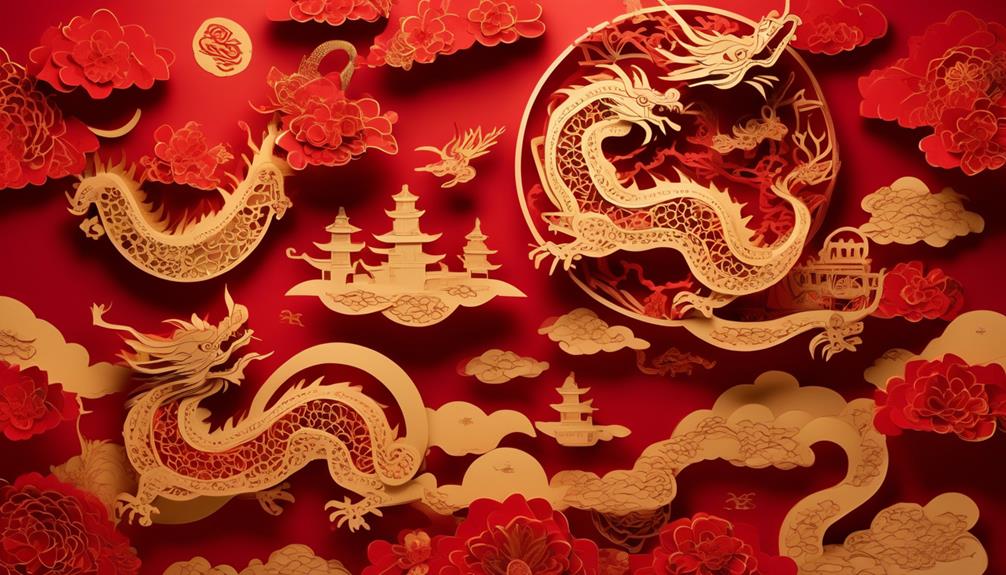
We love how symbolic paper designs and festive window decorations add a touch of elegance to Chinese New Year celebrations.
The intricate paper cutouts often feature symbols of good luck, prosperity, and happiness, making them an essential part of the festive decorations.
These delicate designs can be placed on windows, doors, or walls to bring a sense of joy and auspiciousness to the surroundings.
Symbolic Paper Designs
In Chinese culture, symbolic paper designs, known as elegant paper cutouts, hold significant meaning and are often used as decorative ornaments during the Chinese New Year celebrations. These intricate paper crafts carry deep cultural significance and are created using traditional techniques that have been passed down through generations.
Here are four compelling aspects of these symbolic paper designs:
- Artistic Symbolism: Each paper cutout is rich in symbolism, representing prosperity, good luck, and happiness.
- Intricate Patterns: The designs feature meticulous details and delicate patterns, showcasing the artisan's skill and precision.
- Festive Display: These elegant paper cutouts adorn homes and public spaces, adding a festive and auspicious atmosphere to the New Year celebrations.
- Cultural Preservation: The art of creating symbolic paper designs is a cherished tradition, reflecting the preservation of Chinese cultural heritage.
These elegant paper cutouts not only enhance the visual appeal but also carry profound cultural significance, making them an integral part of Chinese New Year decorations.
Festive Window Decorations
Adorning windows with festive elegant paper cutouts adds a touch of cultural charm to Chinese New Year celebrations.
Festive paper crafts, such as intricate paper cuts of zodiac animals, blooming flowers, and auspicious symbols, are commonly used to create stunning window displays.
DIY enthusiasts can indulge in creating these creative window decorations by using red and gold paper, symbolic of luck and prosperity. The process involves delicate cutting and folding, resulting in breathtaking displays that catch the light and cast beautiful shadows.
These window decorations not only add to the visual spectacle of the festivities but also hold deep cultural significance. They symbolize good fortune, happiness, and the welcoming of the new year.
Embracing this tradition allows us to immerse ourselves in the rich tapestry of Chinese New Year customs and rituals.
Lucky Symbols and Charms
Amid the vibrant and festive decorations during Chinese New Year, families often include lucky symbols and charms to bring prosperity and good fortune into their homes. These symbols and charms hold deep cultural significance and are believed to attract positive energy for the coming year. The auspicious colors of red and gold are prominently featured in these decorations, symbolizing luck, happiness, and prosperity.
Here are four popular lucky symbols and charms commonly used during Chinese New Year:
- Fu Character: The Chinese character for 'fu' (福) is often displayed upside down to symbolize that good fortune has arrived, as the word for 'upside down' in Chinese sounds similar to 'arrive.'
- Red Envelopes: Red envelopes filled with money are given to children and unmarried individuals as a symbol of good luck and prosperity for the upcoming year.
- Tangerines and Oranges: These fruits are often displayed and exchanged as they symbolize wealth and good fortune.
- Chinese Knots: These intricate knots, often in red or gold, are hung as decorations to symbolize good luck and longevity.
These lucky symbols and charms play a significant role in the festive celebrations, adding an extra layer of meaning and tradition to the Chinese New Year decorations.
Festive Door Couplets
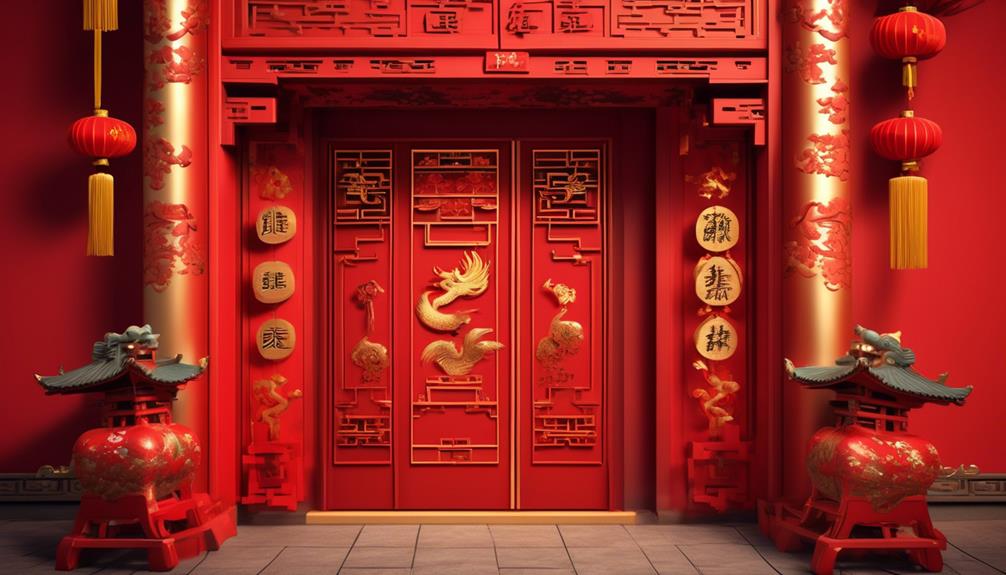
Let's talk about the significance of Festive Door Couplets during Chinese New Year.
These couplets are rich in meaning and are traditionally adorned with beautiful calligraphy.
The symbolism and colors used in the couplets hold deep cultural significance.
Meaningful Couplets
Festive Door Couplets, also known as Meaningful Couplets, are an essential part of Chinese New Year decorations, symbolizing good luck and happiness.
- Cultural Traditions: These couplets reflect the rich cultural heritage of China, showcasing traditional beliefs and values passed down through generations.
- Symbolic Artistry: Each character in the couplet is carefully chosen for its auspicious meaning, creating a profound and symbolic piece of art.
- Auspicious Messages: The couplets often contain auspicious messages, such as wishes for prosperity, longevity, and harmony, adding an uplifting ambiance to the festive season.
- Doorway Blessings: Placed on both sides of the door, these couplets are believed to ward off evil spirits and invite good fortune into the home, signifying the start of a prosperous new year.
Traditional Calligraphy Art
Creating traditional calligraphy art for festive door couplets requires precision and skill to convey auspicious messages and symbolize good fortune. Traditional brush techniques, passed down through generations, are essential for mastering the art of calligraphy.
Each stroke and character carries deep symbolic meanings, reflecting China's rich cultural heritage. The characters chosen for the couplets are carefully selected to bring blessings and luck to the household. It's not just about writing; it's about understanding the significance behind each word and infusing it with artistic expression.
While honoring tradition, modern interpretations also play a role in keeping this art form relevant and vibrant. The fusion of ancient techniques with contemporary creativity keeps the tradition alive, appealing to both seasoned calligraphers and enthusiasts seeking to delve into this profound and visually captivating art form.
Symbolism and Colors
Mastering the art of traditional calligraphy for festive door couplets requires precision and skill to convey auspicious messages and symbolize good fortune. Understanding the symbolism and colors adds depth to the artistic expression. Here are four key points to enhance your understanding:
- Symbolism of Traditional Colors: The colors used in festive door couplets hold significant meanings. Red symbolizes good luck and happiness, while gold represents wealth and prosperity.
- Significance of Decorative Elements: Traditional Chinese New Year symbols like the dragon, phoenix, and peony are often incorporated into the design of door couplets. The dragon symbolizes power and strength, the phoenix represents renewal and rebirth, and the peony signifies prosperity and good fortune.
- Balance and Harmony: The arrangement of colors and decorative elements in the couplets aims to create a harmonious and balanced composition, reflecting the principles of yin and yang.
- Cultural Legacy: By understanding the symbolism and colors, one can appreciate and preserve the rich cultural heritage passed down through generations.
Auspicious Wall Scrolls

As we prepare for Chinese New Year, auspicious wall scrolls play a significant role in adding a traditional and symbolic touch to the festive decorations. Symbolic wall hangings hold deep cultural significance in Chinese traditions, representing blessings, good fortune, and prosperity. These auspicious wall scrolls are meticulously crafted using traditional techniques, embodying the rich heritage of Chinese craftsmanship.
| Symbol | Meaning |
|---|---|
| Fu (福) | Represents good fortune and happiness |
| Shou (寿) | Symbolizes longevity and good health |
| Cai (财) | Signifies wealth and prosperity |
Auspicious wall scrolls are adorned with these powerful symbols, each holding its own unique significance and contributing to an atmosphere of positivity and good luck. The intricate calligraphy and vibrant colors of these scrolls further enhance their visual appeal, making them a captivating addition to the New Year decorations.
In Chinese culture, these wall scrolls are believed to bring harmony and blessings to the household, making them an essential part of the New Year celebrations. The display of these traditional artworks not only adds an aesthetic charm but also reflects a deep-rooted belief in auspiciousness and the timeless beauty of Chinese artistry.
Colorful Dragon and Lion Dance Props
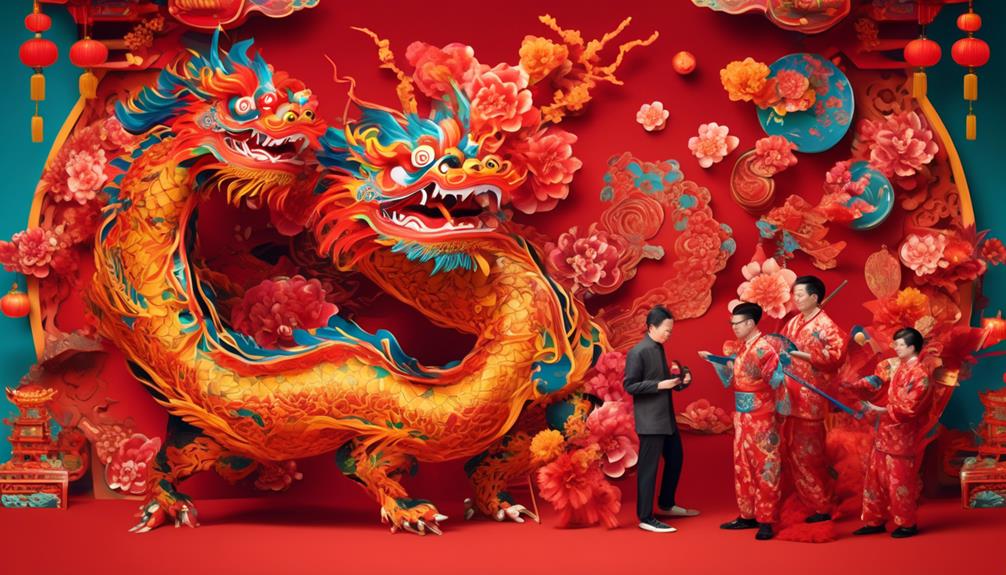
We're excited to explore the cultural significance of the colorful dragon and lion dance props used in Chinese New Year celebrations. These vibrant and dynamic props hold deep symbolic meaning and are a key element of the festive traditions.
Additionally, we'll discuss the various costume variations in the lion dance that add an extra layer of visual spectacle to the performances.
Cultural Significance of Dragons
The colorful dragon and lion dance props hold significant cultural importance in Chinese traditions, symbolizing power, strength, and good fortune. Understanding the cultural significance of dragons enhances the appreciation of these majestic dance props.
- Dragon Mythology and Symbolism: Exploring the mythical origins of dragons in Chinese folklore provides insight into their revered status.
- Dragon Dance Performance Art: Delving into the intricacies of the dragon dance as a performance art form sheds light on its role in traditional celebrations.
- Symbol of Prosperity: Discovering how dragons are associated with prosperity and good luck offers a deeper understanding of their cultural importance.
- Community Unity: Exploring how the dragon dance fosters community unity and reinforces cultural identity highlights its social significance in Chinese culture.
Appreciating the cultural significance of dragons enriches the experience of witnessing the vibrant dragon and lion dance performances during Chinese New Year celebrations.
Lion Dance Costume Variations
Exploring the vibrant variations in lion dance costumes and colorful dragon and lion dance props adds a dynamic element to the traditional Chinese New Year celebrations. The lion dance costume designs are not only visually stunning but also hold deep cultural significance. The colors, patterns, and accessories of the costumes all have symbolic meanings, with red symbolizing good fortune and happiness, and gold representing wealth and prosperity. Each region in China has its own unique style of lion dance costume, showcasing the diversity of Chinese culture. Furthermore, the cultural significance of dragons is also reflected in the design of these costumes, as dragons are revered creatures in Chinese mythology, symbolizing power, strength, and good luck. The table below illustrates the various lion dance costume designs and their cultural meanings.
| Lion Dance Costume Design | Colors | Symbolic Meanings |
|---|---|---|
| Southern Lion | Bright colors like red, green, and yellow | Symbolizes joy and happiness |
| Northern Lion | Bold and vibrant colors such as blue, orange, and white | Represents power and strength |
| Dragon Dance Costume | Red, gold, and other vibrant colors | Signifies good luck, prosperity, and power |
Ornate Tassel Decorations

Adorning doorways and lanterns with ornate tassel decorations is a traditional way to bring luck and prosperity during Chinese New Year celebrations. Here are some key points about ornate tassel decorations:
- Tassel Color Meanings: Each color of tassel holds symbolic meaning. Red tassels symbolize good luck and happiness, while gold tassels represent wealth and prosperity. Incorporating these colors into tassel decorations enhances their significance.
- Tassel Crafting Techniques: Intricate knotting and weaving techniques are used to create ornate tassel decorations. Skilled artisans meticulously craft these tassels using traditional Chinese knotting methods, adding a touch of elegance and cultural significance to the decorations.
- Symbolism and Significance: Tassel decorations aren't only visually appealing but also hold deep cultural symbolism. They're believed to ward off evil spirits and bring positive energy into the space, making them an essential part of Chinese New Year decor.
- Variety and Versatility: Ornate tassel decorations come in various designs, from simple tassels to more elaborate and intricate designs. They can be hung on doorways, lanterns, and even on gifts, adding a festive touch to the surroundings.
Incorporating ornate tassel decorations into Chinese New Year festivities brings an element of tradition and elegance, enriching the celebratory atmosphere.
Prosperity Blossom Plants

When it comes to Chinese New Year decorations, the symbolism behind prosperity blossom plants is significant. These plants are believed to bring good luck and prosperity, making them an essential part of the festive decor.
Understanding the symbolic meanings and the auspicious placement of these plants is essential for creating a harmonious and prosperous atmosphere during the Chinese New Year celebrations.
Symbolic Plant Meanings
Symbolizing abundance and growth, prosperity blossom plants are an integral part of Chinese New Year decorations. They carry deep meanings in Chinese culture, signifying good fortune, prosperity, and renewal.
Some important symbolic plant meanings include:
- Plum Blossom: Represents resilience and perseverance in the face of adversity.
- Peach Blossom: Symbolizes longevity and romance, bringing blessings for a happy marriage.
- Cherry Blossom: Signifies the beauty of life and the transient nature of existence, urging us to cherish every moment.
- Kumquat Tree: Represents wealth and prosperity, often displayed with ripe fruits to symbolize a bountiful year ahead.
Understanding the plant symbolism in traditional decorations allows for modern interpretations that hold deep cultural significance while also bringing a touch of elegance and auspiciousness to the Chinese New Year celebrations.
Placement for Luck
Placing prosperity blossom plants in key areas of the home is believed to attract luck and abundance during the Chinese New Year celebrations. Traditional customs dictate that placing these plants in the southeast corner of the house or in the wealth sector of each room can enhance prosperity. The vibrant blooms and lush greenery of these plants symbolize growth, rejuvenation, and good fortune, making them ideal for ushering in the new year.
In Chinese culture, the art of placement, known as feng shui, plays a significant role in harnessing positive energy. It's also important to ensure that the plants are well-maintained and healthy, as wilting or withering foliage can symbolize the opposite of prosperity.
Mandarin Orange Display

We carefully arrange the vibrant mandarin oranges in decorative displays to bring prosperity and good fortune to our homes during the Chinese New Year celebrations. The creative arrangements and symbolic fruit decorations play a significant role in enhancing the festive atmosphere and symbolizing abundance and good luck.
Here are four key elements that make the mandarin orange display an essential part of Chinese New Year decor:
- Feng Shui Principles: We meticulously follow feng shui guidelines to position the mandarin oranges in specific areas of the house to attract positive energy and good fortune.
- Colorful Contrasts: By pairing the bright orange hues of the mandarins with complementary colors and textures, we create visually stunning displays that serve as focal points in our homes.
- Traditional Significance: We incorporate traditional Chinese symbols, such as the character for 'luck,' or auspicious images like fish or peonies, into the displays to amplify the positive meanings associated with the mandarin oranges.
- Harmonious Groupings: We arrange the mandarin oranges in groups of eight or nine, as these numbers are considered auspicious in Chinese culture, symbolizing wealth, longevity, and eternity.
Our attention to detail and adherence to traditional customs ensure that our mandarin orange displays bring an abundance of prosperity and good fortune into our homes during the Chinese New Year festivities.
Intricate Fu Character Art
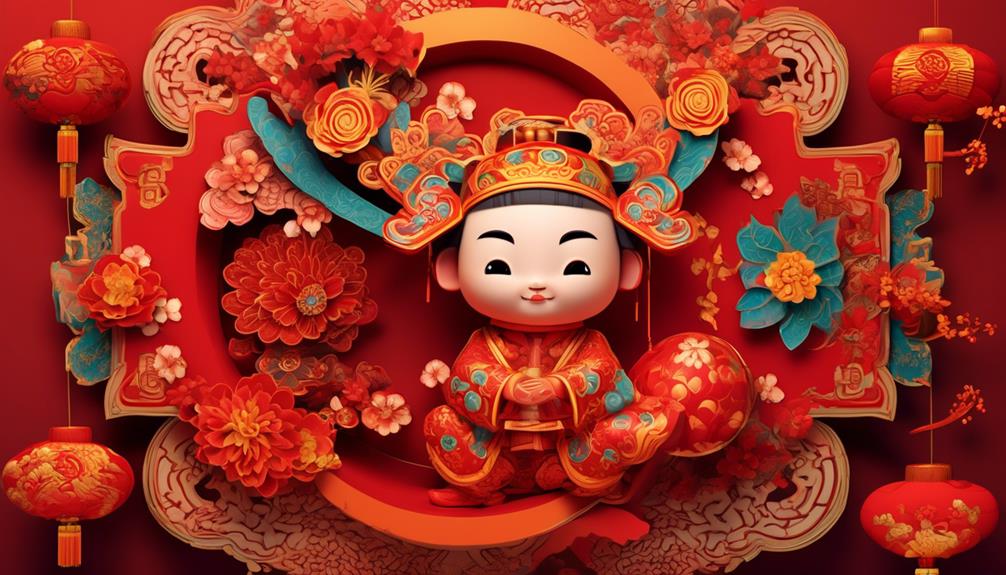
Adorning our homes with intricate Fu character art adds a touch of traditional symbolism and auspicious meaning to our Chinese New Year decorations. The Fu character holds deep cultural significance in Chinese tradition, representing good fortune and happiness. Its intricate strokes and elegant form are often crafted using traditional calligraphy techniques, reflecting the artistry and craftsmanship of Chinese culture.
The Fu character symbolism goes beyond mere aesthetic appeal; it embodies profound wishes for the upcoming year. Each stroke in the character holds specific meanings, emphasizing the importance of balance and harmony, qualities highly valued in Chinese culture. The art of crafting this symbol requires precision and skill, making it a revered form of expression during the festive season.
Intricate Fu character art not only serves as a visual adornment but also as a reminder of the rich cultural heritage and the aspirations for a prosperous year ahead. Its presence in homes during Chinese New Year celebrations reflects the enduring traditions and values that have been passed down through generations.
Joyful Firecracker Ornaments

As we immerse ourselves in the vibrant traditions of Chinese New Year, the intricate Fu character art gives way to the lively presence of joyful firecracker ornaments. These ornaments are a symbol of joy and celebration, and they play a significant role in the festive decorations during this auspicious time.
Here are four reasons why joyful firecracker ornaments are an essential part of the Chinese New Year celebration:
- Symbol of Celebration: Joyful firecracker ornaments symbolize the celebratory fireworks that light up the sky during Chinese New Year, spreading happiness and good wishes.
- Traditional Significance: These ornaments are deeply rooted in the cultural traditions of Chinese New Year, signifying the festive spirit and the arrival of a prosperous new year.
- Vibrant Display: Adorning homes and public spaces with these ornaments adds a colorful and lively touch to the surroundings, creating a festive atmosphere that resonates with the spirit of the occasion.
- Festive Parade: During the festive parade, these ornaments are often featured prominently, adding to the jubilant ambiance and infusing the air with an infectious sense of joy and excitement.
Golden Ingot Embellishments

Glittering with prosperity and symbolic significance, the golden ingot embellishments bring an aura of wealth and auspiciousness to the Chinese New Year decorations. Symbolizing prosperity and wealth, the golden ingot, or sycee, has been an integral part of Chinese culture for centuries. These ingots were historically used as currency, and their representation in decorations during Chinese New Year symbolizes the wish for prosperity and good fortune in the coming year. The significance of the gold ingot lies in its association with wealth and abundance, making it a highly valued symbol during the festive season.
To truly understand the importance of golden ingots in Chinese New Year decorations, it's essential to acknowledge their symbolic significance:
| Symbolic Prosperity | Gold Ingot Significance |
|---|---|
| Represents wealth and prosperity | Symbolizes the wish for abundance in the coming year |
| A traditional Chinese currency | Reflects the desire for financial success and good fortune |
| Associated with good luck and prosperity | Brings an aura of wealth and auspiciousness to the festive decorations |
| Carries historical significance | Adds depth and cultural richness to the New Year celebrations |
| Often given as gifts | Reflects the gesture of wishing prosperity upon others |
The inclusion of golden ingot embellishments in Chinese New Year decorations not only adds opulence and grandeur but also imbues the festivities with the traditional values of prosperity and good fortune.
Festive Table Centerpieces
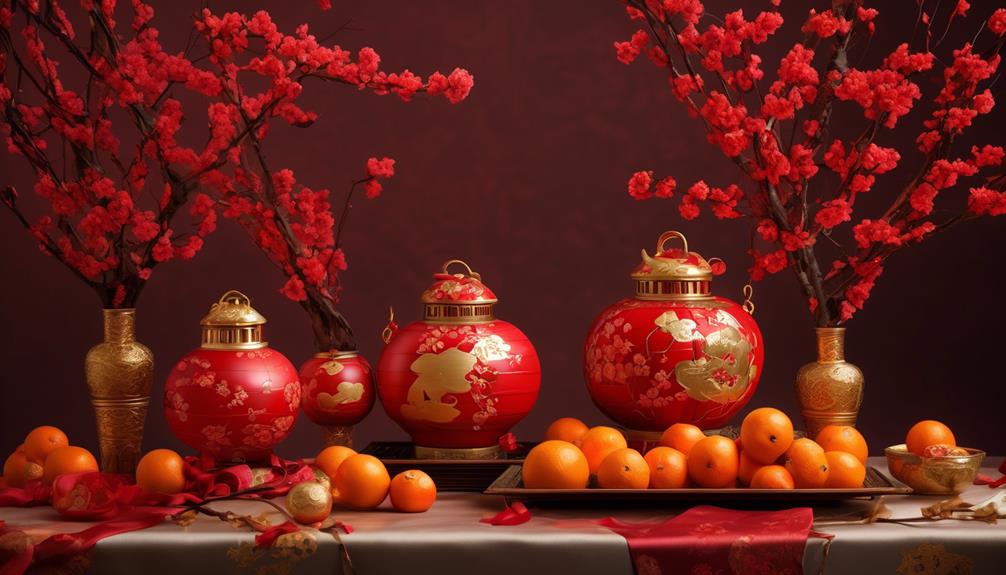
We will now explore the captivating allure of festive table centerpieces, a focal point of vibrant splendor and cultural significance during Chinese New Year celebrations.
- Traditional Floral Elegance: Embrace the spirit of the festival with exquisite festive flower arrangements featuring auspicious blooms such as peonies, orchids, and chrysanthemums, symbolizing wealth, success, and longevity.
- Symbolic Table Settings: Elevate your creative table settings with symbolic elements like tangerines, representing good luck and prosperity, and red lanterns, signifying joy and good fortune, to create an ambiance of abundance and happiness.
- Harmonious Color Palette: Infuse your centerpiece with a harmonious blend of red, gold, and black, emblematic of good fortune, wealth, and prosperity, to create a visually stunning focal point that captures the essence of the Chinese New Year.
- Cultural Significance: Incorporate traditional Chinese symbols such as the Chinese character for 'spring' or the iconic dragon and phoenix, representing harmony and balance, into your centerpiece to honor the rich cultural heritage of the festival.
Festive table centerpieces serve as a reflection of the joyous spirit and deep-rooted traditions of the Chinese New Year, infusing the celebratory atmosphere with beauty, symbolism, and cultural significance.
Symbolic Zodiac Animal Figurines

With the captivating allure of festive table centerpieces setting the stage, we turn our attention to the symbolic zodiac animal figurines, which hold deep cultural significance in Chinese New Year celebrations. The zodiac animal symbolism is an integral part of Chinese astrology and folklore, with each animal representing different personality traits and characteristics. These figurines aren't just decorative arrangements; they carry profound meanings that resonate with the essence of the Chinese zodiac.
In Chinese culture, each zodiac animal is believed to influence the personality and destiny of individuals born under its sign. During Chinese New Year, these figurines are prominently displayed to usher in the associated attributes of the zodiac animal for the coming year. For example, the rat signifies wealth and surplus, while the ox represents diligence and hard work. The decorative arrangements of these figurines are carefully chosen to align with the specific zodiac animal of the year, creating an atmosphere infused with the symbolic power of the animal.
The cultural significance of these zodiac animal figurines extends beyond mere ornamentation, embodying the rich tapestry of beliefs and traditions that underpin Chinese New Year celebrations.
Decorative Red Envelopes
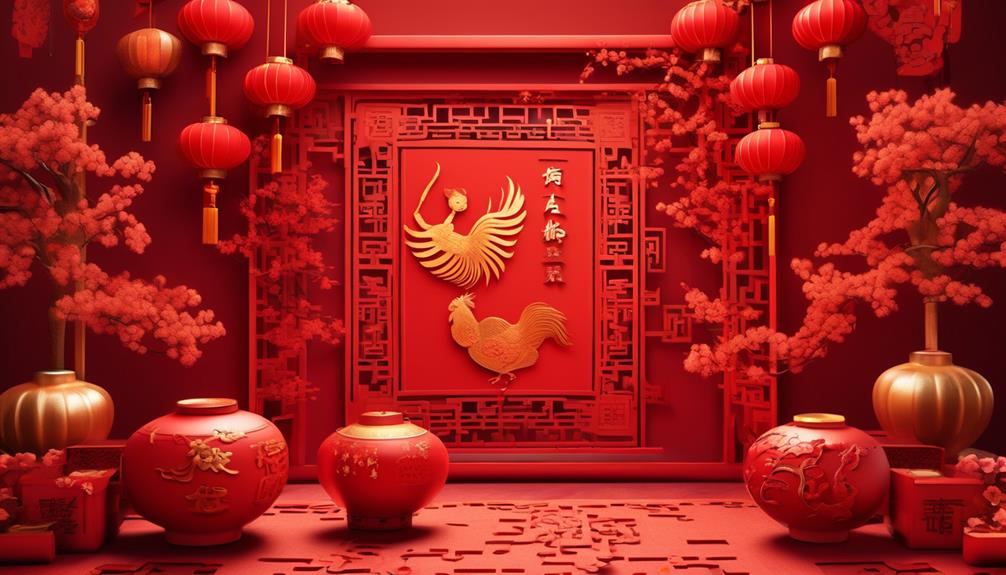
Adorning doorways and mantelpieces, decorative red envelopes add a vibrant touch to Chinese New Year celebrations. These auspicious envelopes aren't only visually appealing but also carry deep cultural significance.
Here's why they're an essential part of the festivities:
- Symbolism: Red symbolizes good luck and is believed to ward off evil spirits, making red envelopes an embodiment of good fortune and blessings.
- Traditional Designs: From intricate floral patterns to elegant calligraphy, red envelopes feature traditional designs that showcase the rich artistic heritage of Chinese culture.
- Decorative Tassel Designs: Elaborate tassels attached to the envelopes not only enhance their visual appeal but also represent prosperity and abundance.
- Meaningful Symbolism in Red Envelopes: Beyond their decorative appeal, red envelopes are filled with money and gifted to symbolize prosperity and good wishes for the recipient.
These symbolic and decorative red envelopes are a cherished part of Chinese New Year traditions, embodying the spirit of hope, prosperity, and goodwill for the coming year.
Frequently Asked Questions
What Are the Traditional Meanings and Symbolism Behind the Designs of the Festive Door Couplets and Auspicious Wall Scrolls?
We cherish the traditional meanings and symbolism behind festive door couplets and auspicious wall scrolls. These intricate designs carry deep cultural significance, representing blessings, good fortune, and prosperity.
The festive door couplets symbolize warding off evil spirits and welcoming good luck. They are often seen on the doors of homes during Chinese New Year. The couplets are typically written in red ink on strips of red paper and are placed vertically on both sides of the door.
On the other hand, auspicious wall scrolls often feature calligraphy and images of auspicious symbols, such as the dragon or phoenix. These symbols are believed to bring positive energy into the home during Chinese New Year. The wall scrolls are usually hung in prominent places, like the living room or the main entrance, to invite good luck and happiness into the house.
Both festive door couplets and auspicious wall scrolls play a significant role in Chinese culture and traditions. They not only add a festive touch to the decorations but also serve as a reminder of the hopes and aspirations for the coming year.
Are There Specific Traditions or Customs Associated With the Display of Mandarin Oranges During Chinese New Year?
Yes, there are specific traditions and customs associated with the display of mandarin oranges during Chinese New Year. Mandarin oranges hold cultural significance and are often used as decorative accessories during the festive season.
They symbolize wealth, prosperity, and good luck. It's customary to display them in homes and businesses as auspicious decorations to usher in good fortune for the coming year.
How Are the Intricate Fu Character Art Pieces Typically Displayed and What Do They Symbolize?
We typically display the intricate fu character art pieces in prominent locations, such as the front door or living room.
The fu character symbolizes good fortune and blessings, and its display is believed to bring luck and prosperity for the coming year.
It's often paired with festive door couplets to enhance the overall auspicious atmosphere during Chinese New Year celebrations.
What Is the Significance of the Symbolic Zodiac Animal Figurines and How Are They Incorporated Into Chinese New Year Decorations?
Symbolic zodiac animal figurines play a vital role in Chinese New Year decorations. They symbolize attributes of the zodiac animal for the year and incorporating these figurines brings good luck and wards off evil spirits. Their significance lies in the traditional meanings and symbolism they represent.
From festive door couplets to auspicious wall scrolls, these figurines are seamlessly integrated into the decorations. They add a touch of tradition and cultural richness to the festivities.
Can You Provide Tips on How to Properly Display and Distribute Decorative Red Envelopes During Chinese New Year Celebrations?
Sure,
When it comes to distributing decorative red envelopes during Chinese New Year celebrations, it's important to do so with intention and respect. Proper distribution involves giving envelopes to children, unmarried individuals, and elders as a symbol of good fortune.
Display tips include arranging envelopes in a decorative container or using them to adorn the home, bringing prosperity and luck to all who see them.
How Can I Incorporate Chinese New Year Decorations into Decoration Day?
To incorporate Chinese New Year decorations into Decoration Day, consider adding traditional red lanterns, lucky red envelopes, and symbolic paper cutouts to your display. Embracing the color red and incorporating traditional Chinese symbols can add a festive touch to what Decoration Day entails.
Conclusion
As we celebrate Chinese New Year, let's not forget the importance of beautiful accessories and decorations to bring good luck and prosperity into our homes.
From traditional red lanterns to elegant paper cutouts, each item holds a special meaning and adds to the festive atmosphere.
So let's embrace the vibrant colors, intricate designs, and symbolic ornaments to bring in the Year of the Ox with a bang!
After all, a little decoration goes a long way in setting the mood for a prosperous year ahead.
- About the Author
- Latest Posts
Introducing Ron, the home decor aficionado at ByRetreat, whose passion for creating beautiful and inviting spaces is at the heart of his work. With his deep knowledge of home decor and his innate sense of style, Ron brings a wealth of expertise and a keen eye for detail to the ByRetreat team.
Ron’s love for home decor goes beyond aesthetics; he understands that our surroundings play a significant role in our overall well-being and productivity. With this in mind, Ron is dedicated to transforming remote workspaces into havens of comfort, functionality, and beauty.
Decor
How to Turn a Dresser Into a Bookshelf in 10 Steps
Start transforming an old dresser into a functional bookshelf with these 10 steps, but be prepared for a dramatic makeover.

We'll start by examining the dresser's top drawer supports, evaluating the interior for measurements, and removing the drawers to pave the way for our bookshelf conversion. Next, we'll add cleats for shelf support, trim and refine the shelf edges, and convert the drawers into shelves. Sanding and refining the surface will come next, followed by applying paint and finish coatings. We'll add bottom trim and details, and finally, assemble and touch up the bookshelf. With attention to detail and careful planning, we'll transform an old dresser into a functional bookshelf. And that's just the beginning – there's more to explore in our conversion process.
Key Takeaways
• Remove top drawer supports and assess the interior for measurements to plan the bookshelf conversion.
• Convert drawers into shelves by adding cleats and trimming front facings for a seamless integration.
• Add shelf supports with cleats to prevent sagging and refine shelf edges for a polished look.
• Apply a finish coating, such as polyurethane seal, and consider distressing techniques for an aged look.
• Securely attach shelf boards and ensure stability with wood screws, then fill gaps with wood glue for a smooth surface.
Prepare the Dresser for Conversion
As we begin the process of transforming our dresser into a bookshelf, we must first remove the top drawer supports to pave the way for the conversion. This initial step is paramount in preparing the dresser for its new purpose.
We'll use a reciprocating saw to cut through the wood, making sure to carefully navigate around any screws or other obstacles. Once we've made the necessary cuts, we'll use a hammer and chisel to pop out the remaining pieces, taking care not to damage the surrounding wood.
With the top drawer supports removed, we'll be able to assess the interior of the dresser and take precise measurements to guide our conversion. The wood inside the dresser will serve as the foundation for our bookshelf, so it's essential that we accurately measure and prepare the space.
Remove Drawers and Add Shelves
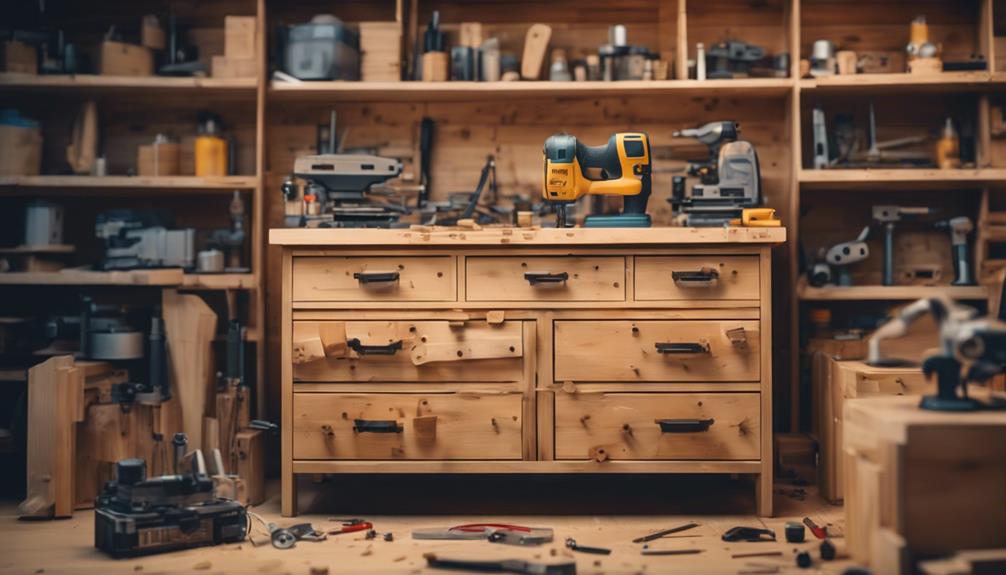
With the top drawer supports removed, we'll start by pulling out the drawers to create space for our shelves. This will give us a clear canvas to work with, allowing us to visualize and plan our shelving layout. Next, we'll measure and cut pieces to fit inside the dresser, creating the shelves that will hold our books and decor.
| Shelf Size | Material | Purpose |
|---|---|---|
| 30' x 12' | 3/4' Plywood | Top Shelf |
| 30' x 10' | 3/4' Plywood | Middle Shelf |
| 30' x 8' | 3/4' Plywood | Bottom Shelf |
| 30' x 6' | 1/2' MDF | Decor Shelf |
| 30' x 4' | 1/2' MDF | Top Trim |
As we add the shelves, we'll secure them with cleats for support and stability. This will safeguard that our bookshelf is sturdy and can hold a substantial amount of weight. By repurposing the dresser drawers, we'll create functional storage spaces for books or decor items, giving our bookshelf a unique touch.
Add Cleats for Shelf Support

We attach cleats to the sides of the dresser, strategically placing them to provide maximum support for our shelves and guarantee our bookshelf remains sturdy and stable. These small strips of wood are vital for distributing weight evenly and preventing sagging in the shelves over time. We secure them with screws or nails to make sure they're firmly in place.
Properly installed cleats are essential for the structural integrity of our bookshelf, so we take our time to get it right. The size and placement of the cleats can be customized based on the dimensions of the dresser and our desired shelf layout.
Trim and Refine Shelf Edges
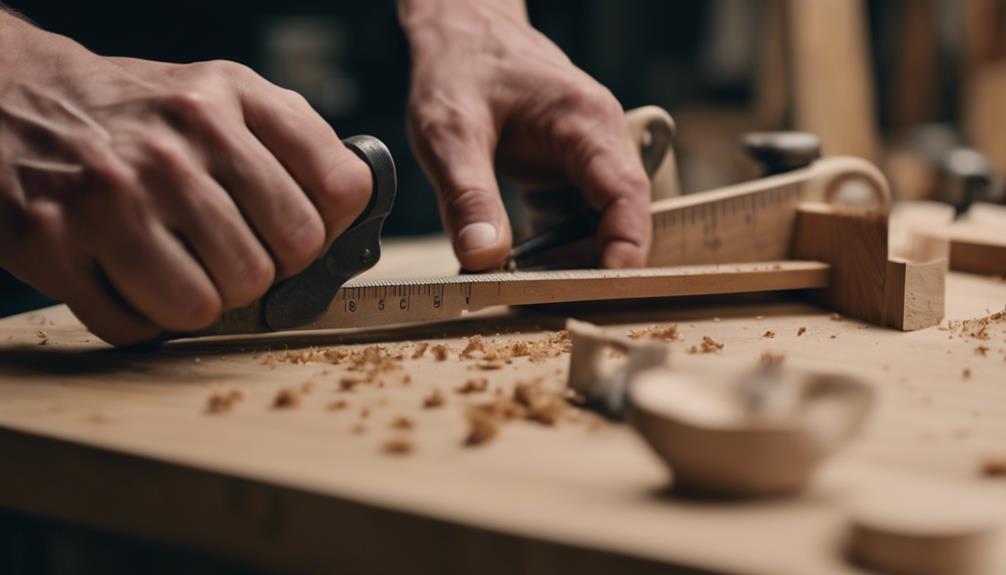
Now that our shelves have sturdy support, we're ready to refine their edges, smoothing out any rough spots and adding a decorative touch to complete their transformation.
We start by sanding down any rough edges on the shelves for a smooth finish. This guarantees that our bookshelf turned out great, with no splinters or rough spots to detract from its appearance.
Next, we use a router to create decorative trim on the edges of the shelves, adding a touch of elegance to our design. If there are any gaps or imperfections in the shelf edges, we apply wood filler to smooth them out. We also consider adding a beveled edge to the shelves for a more polished look.
Convert Drawers Into Shelves

By removing the drawers from the dresser, we create the space needed to insert our new shelves. This step is essential in converting the dresser into a functional bookshelf.
We'll repurpose the drawers into shelves, giving us ample storage for our books and decorative items. To do this, we'll measure and cut shelf pieces to fit snugly inside the dresser. Next, we'll add cleats for shelf support to hold the shelves in place.
If needed, we'll trim the front facings of the drawers to adjust the shelf depth. This will guarantee a seamless integration of the new shelves into the dresser turned bookshelf.
Remove Unnecessary Pieces

Let's clear out the unnecessary pieces to make way for our shelves, starting with the top drawer supports, which we'll remove to create the space we need. Using a reciprocating saw, we'll cut through any excess wood that's not needed, making sure to measure the inside dimensions of the dresser to guarantee accurate cutting of new pieces.
| Tool | Purpose |
|---|---|
| Reciprocating saw | Cut excess wood |
| Hammer and chisel | Remove remaining wood pieces |
| Jig saw | Create curved bottom piece |
With the top supports gone, we'll use a hammer and chisel to pop out any remaining wood pieces, leaving a clean slate for our shelves. We might end up with a few pieces of scrap, but that's okay – we can use those to create custom wood pieces later on. For now, let's focus on clearing out the old to pave the way for the new.
Sand and Refine the Surface
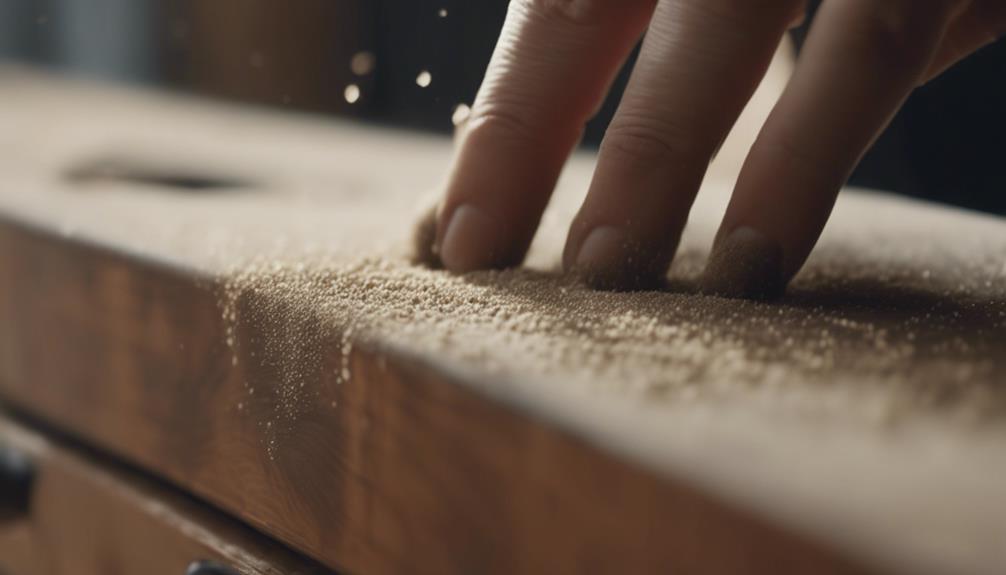
As we progress with transforming our dresser into a bookshelf, we're now at the pivotal step of sanding and refining the surface.
We'll focus on smoothing out imperfections and removing the old finish, ensuring a clean slate for our new project.
Smooth Out Imperfections
We grab our orbital sander and 80 grit sandpaper to tackle the dresser's surface, smoothing out imperfections and rough spots that could derail our bookshelf transformation. As we work, we pay close attention to details like corners and edges, making sure they're polished and even.
While the orbital sander does most of the heavy lifting, we also take the time to refine the surface with some hand sanding, focusing on hard-to-reach areas that the sander can't quite get to.
We sand the entire dresser surface with 80 grit sandpaper to remove imperfections and rough spots.
We use an orbital sander to achieve a smooth and even finish on the dresser.
We refine the surface by hand sanding hard-to-reach areas for a consistent texture.
Remove Old Finish
With the dresser's surface now smooth and even, we tackle the old finish, using an orbital sander with 80 grit sandpaper to strip away the existing coat and reveal a fresh canvas for our bookshelf transformation. This important step guarantees a clean slate for our new design, allowing the paint or stain to adhere better and ensuring a more even application.
As we work the sander across the surface, we're not only removing the old finish but also refining the wood to create a smooth surface. Any imperfections or damage are sanded away, leaving a clean and even texture that's ready for the next step.
We take our time, working methodically to make sure every inch of the dresser is free of the old finish. With the surface now clean and smooth, we're one step closer to transforming this old dresser into a beautiful bookshelf.
Apply Paint and Finish Coatings

As we move forward with applying paint and finish coatings to our dresser-turned-bookshelf, we'll explore the various options available to us.
We'll consider the paint color options that will best suit our desired aesthetic, whether that's a bold statement or a subtle accent.
Next, we'll discuss the finish coating techniques that will enhance and protect our chosen hue.
Paint Color Options
Often, we find that selecting the ideal paint color is the most crucial step in transforming a dresser into a beautiful bookshelf. The right paint color can elevate the overall aesthetic of the piece, making it blend seamlessly with its new surroundings.
When it comes to choosing a paint color, we've a few favorites that always seem to impress.
- Sherwin Williams Tricorn Black for a dramatic, sleek look
- ASCP Old White for a soft, vintage vibe
- Simplicity for a clean, modern feel
Consider adding a contrasting paint color like Minwax Dark Walnut or Ebony for the trim to create visual interest. It's also important to think about the existing decor and color scheme in the room to achieve a cohesive and harmonious finish.
Finish Coating Techniques
To guarantee, it's crucial to bring our dresser-turned-bookshelf to life by applying a flawless finish coat that showcases our carefully chosen paint color. Now that we've selected the perfect hue, it's time to apply it using a high-quality brush or roller. For larger surfaces, a paint sprayer can provide a smooth and even finish. Remember to allow the paint to dry completely before applying a second coat for full coverage.
| Finish Coating Technique | Description |
|---|---|
| Base Coat | Apply a thin layer of paint to the dresser using a brush or roller |
| Second Coat | Apply a second layer of paint for full coverage |
| Polyurethane Seal | Seal the painted surface with a clear finish for protection |
| Distressing | Apply distressing techniques for a unique, aged look |
| Wax Finish | Apply a wax finish for a subtle sheen |
When working with solid wood, it's important to make sure the surface is smooth and even before applying paint. We can use Wood Glue to fill any gaps or imperfections before sanding and painting. By following these finish coating techniques, we'll achieve a beautiful, long-lasting finish that complements our newly transformed bookshelf.
Add Bottom Trim and Details
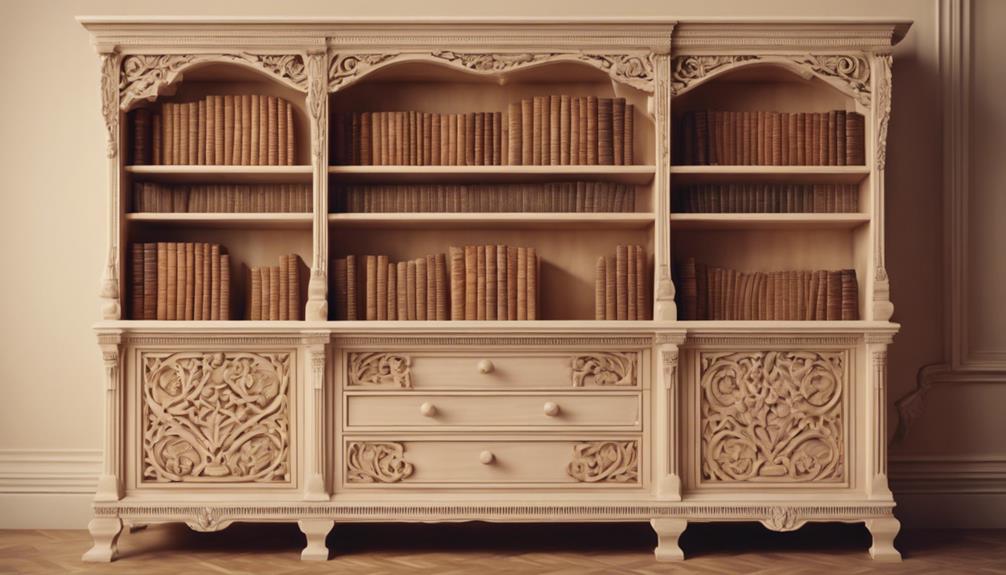
We add the final touches to our dresser-turned-bookshelf by attaching bottom trim. This trim not only enhances the overall aesthetic but also conceals any imperfections that may have arisen during the conversion process. It provides a finished look to the bottom of our bookshelf, tying the entire piece together.
To take our bookshelf to the next level, we can also add some extra details. Here are a few ideas:
- Add decorative feet or baseboard molding to elevate the design of our bookshelf
- Choose a complementary color for the bottom trim to match our bookshelf's overall style
- Incorporate decorative molding or trim to add visual interest to the bottom of our bookshelf
Final Assembly and Touch-ups

With our bookshelf's design elements in place, we can now focus on bringing all the components together to create a sturdy and polished final product. We'll start by securing the assembled bookshelf into the dresser using wood screws for stability. Next, we'll confirm the shelf fits snugly inside the dresser before proceeding with final touches.
| Step | Task | Description |
|---|---|---|
| 1 | Sand and Prime | Prepare assembled pieces for painting |
| 2 | Fill Blemishes | Use wood filler and add trim for a polished look |
| 3 | Paint and Seal | Apply multiple coats and finish with a protective sealant |
We'll sand and prime the assembled pieces to prepare for painting, then fill in any blemishes with wood filler and add trim for a polished look. Finally, we'll apply multiple coats of paint and finish with a protective sealant for durability. Don't forget to attach the drawer fronts securely to the bookshelf frame. With these final touches, our dresser-turned-bookshelf will be ready for use.
Frequently Asked Questions
Can You Turn a Dresser Into a Bookshelf?
We can confidently say that yes, it's absolutely possible to turn a dresser into a bookshelf.
With some creativity and basic woodworking skills, an old dresser can be repurposed into a functional and unique bookshelf.
How to Make Shelves Out of Dresser Drawers?
We're transforming dresser drawers into shelves, a clever storage solution.
First, we remove the drawer glides and attach the drawers to the dresser's frame using screws or nails.
Next, we add supports or cleats to secure the shelves in place.
We can trim the front facings to adjust the shelf depth.
With some creativity, we repurpose the drawers into functional shelves, perfect for holding books, decorative items, or linens.
How to Repurpose Dresser Drawers?
As we breathe new life into old furniture, we're left wondering: how to repurpose dresser drawers?
We envision a creative rebirth, where discarded pieces transform into functional masterpieces. By trimming and adjusting the drawer facings, we can craft unique shelves, adding cleats for support and aesthetic trim for a polished look.
With a little ingenuity, these former drawers become a one-of-a-kind bookcase, perfect for storing treasured volumes.
How to Make a Dresser Look Nicer?
We want to give our dresser a makeover, and we're looking for ways to make it look nicer.
First, we'll sand down the surface to remove imperfections and create a smoother finish.
Next, we'll add a fresh coat of paint or stain to give it a fresh new look.
Then, we'll update the hardware, like knobs or handles, to complete the transformation.
With these simple steps, our dresser will be looking stylish and revitalized in no time!
Conclusion
With our transformed dresser-bookshelf now standing tall, we can confidently say that the end result is well worth the effort. By following these 10 steps, we've successfully repurposed a piece of furniture, giving it new life and a fresh purpose.
The outcome is a demonstration of our creativity and resourcefulness, as we've managed to merge functionality with aesthetics, creating a unique and functional storage solution that will serve us well for years to come.
- About the Author
- Latest Posts
Introducing Ron, the home decor aficionado at ByRetreat, whose passion for creating beautiful and inviting spaces is at the heart of his work. With his deep knowledge of home decor and his innate sense of style, Ron brings a wealth of expertise and a keen eye for detail to the ByRetreat team.
Ron’s love for home decor goes beyond aesthetics; he understands that our surroundings play a significant role in our overall well-being and productivity. With this in mind, Ron is dedicated to transforming remote workspaces into havens of comfort, functionality, and beauty.
Decor
Pergola Remodeling: The Ultimate Guide
Learn how to transform your outdoor space into a stunning oasis with our comprehensive guide to pergola remodeling, from planning to maintenance.
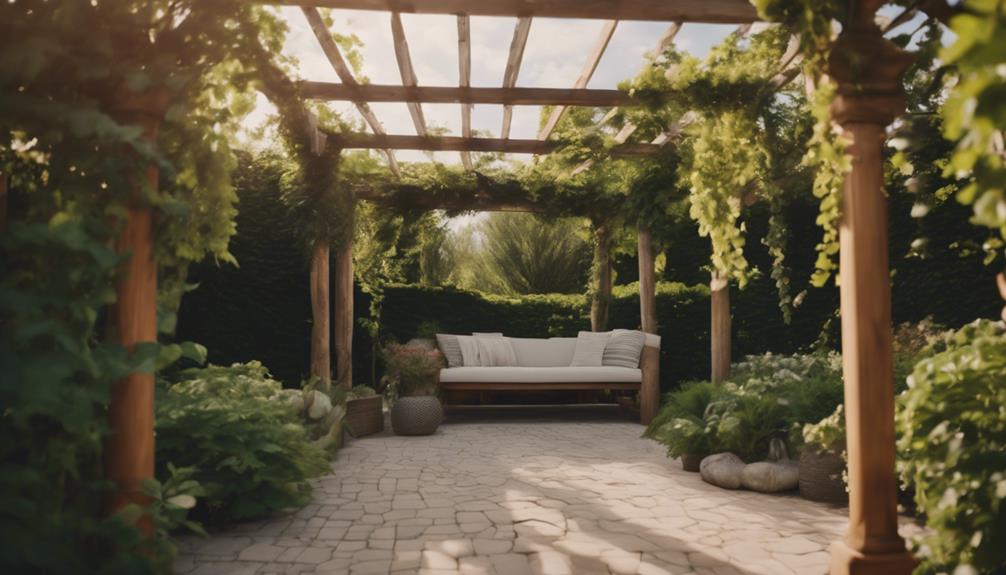
As we begin this ultimate guide to pergola remodeling, we'll cover everything from planning and design to materials, placement, functionality, and maintenance. We'll explore the different types of pergola structures, including gabled roof and arched top designs, and how to choose the perfect materials for your project. From selecting the ideal location and designing for functionality to outdoor lighting essentials and maintenance tips, we'll delve into the details to help you transform your outdoor space. As we delve into this, you'll discover the secrets to creating a stunning oasis that's both beautiful and functional – and we're just getting started.
Key Takeaways
• Assess the current pergola's structure, size, and location to determine the scope of the remodel and create a budget accordingly.
• Choose a pergola design that complements the surrounding environment, considering factors like climate, sunlight, and soil type.
• Select materials that fit the desired look and functionality, such as wood, vinyl, aluminum, composite, or fiberglass, and consider factors like cost and durability.
• Plan for functionality by incorporating features like seating, lighting, and accessories that fit the intended use of the pergola, such as outdoor dining or lounging.
• Ensure a smooth remodel by verifying local building regulations, obtaining necessary permits, and preparing the site before construction begins.
Planning Your Pergola Design
As we begin planning our pergola, we need to take into account the size and location of this outdoor structure to assess the design possibilities based on our space and needs.
We want to create a functional and aesthetically pleasing outdoor space that caters to our lifestyle and preferences. To achieve this, we need to contemplate the location of our pergola and how it will interact with the surrounding environment. We should ponder the climate, sunlight, and soil type to select plants that will thrive in our outdoor space.
Effective planning is key to creating a cohesive look and ensuring our pergola serves its purpose. We should consult with a landscape designer to get expert advice on how to create cozy sitting areas, playgrounds, or lawns within our outdoor space.
Types of Pergola Structures
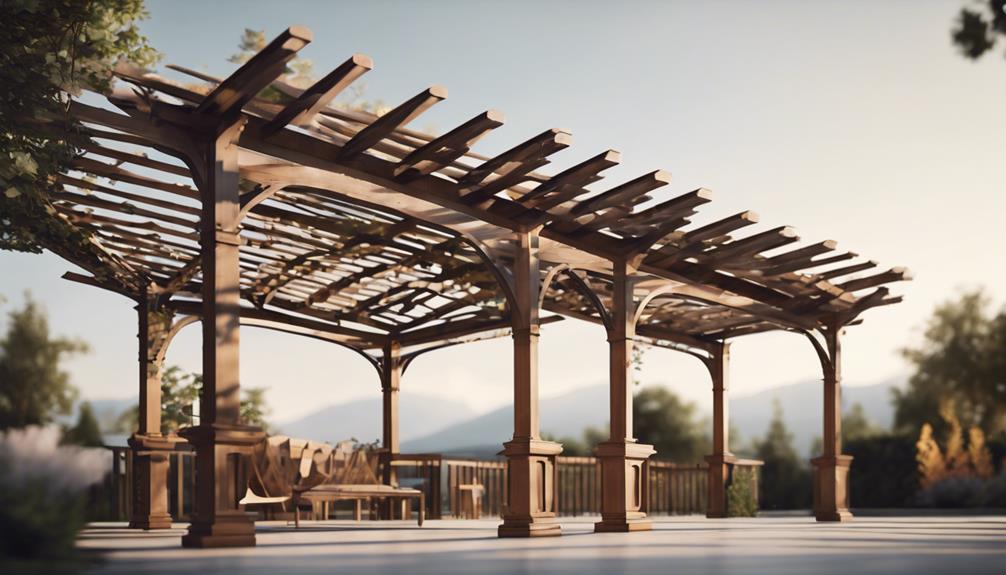
As we explore the world of pergola structures, we're excited to examine the various types that can elevate our outdoor spaces.
From gabled roof pergolas that add a touch of classic charm to arched top designs that bring a sense of elegance, we'll explore the unique characteristics of each style.
Next, we'll take a closer look at column styles that can add a pop of personality to our pergola design.
Gabled Roof Pergolas
We often choose gabled roof pergolas for their timeless charm and functional advantages, which make them a popular choice for enhancing outdoor spaces. These traditional pergola structures feature a sloping roof with two sides meeting at a ridge, providing a classic look that complements any outdoor setting.
One of the significant benefits of gabled roof pergolas is their ability to provide better rain and snow runoff compared to flat roofs, ensuring the structural integrity of our outdoor space. This design also allows for increased air circulation and ventilation, making them ideal for creating a comfortable and inviting atmosphere.
As we explore the Ultimate Guide to Pergola, it's essential to consider the functional benefits of gabled roof pergolas, which make them a popular choice for homeowners. By incorporating a gabled roof pergola into our outdoor space, we can create a beautiful and functional area that's perfect for relaxation and entertainment.
With their classic appeal and practical advantages, it's no wonder gabled roof pergolas remain a popular choice for outdoor remodeling projects.
Arched Top Designs
Beyond traditional flat-top designs, arched top pergolas bring a touch of sophistication to outdoor spaces with their elegantly curved rooflines. We love how these structures add architectural interest and visual appeal to our outdoor areas.
The arched top design provides a softer, more graceful aesthetic compared to traditional flat-top pergolas, making them a great choice for those seeking a unique look. One of the best benefits of arched top pergolas is the additional shade and protection they offer.
The curved roof design provides a sense of enclosure, making outdoor spaces feel cozier and more inviting. Plus, the distinctive aesthetic of arched top pergolas is sure to elevate our outdoor spaces, making them perfect for entertaining or relaxation.
When considering a pergola remodel, we highly recommend incorporating arched top designs for a sophisticated and elegant look. With their curved roof design, arched top pergolas are sure to bring a touch of elegance to any outdoor space, making them a great choice for homeowners looking to upgrade their outdoor areas.
Column Styles
When selecting the perfect pergola design, choosing the right column style is essential, as it sets the tone for the entire structure and can greatly impact the overall aesthetic of our outdoor space.
We want to choose the right column style that complements our outdoor decor and personal taste. Traditional pergola columns include Tuscan, Doric, Ionic, and Corinthian styles, which evoke a classic and timeless feel.
On the other hand, modern pergola designs feature sleek and minimalist column structures that exude a sense of sophistication. We can also customize our column styles to match the overall design theme of our pergola.
Round, square, tapered, or fluted columns can be used to enhance the pergola's aesthetic. The materials we can choose from are just as varied, ranging from wood, fiberglass, aluminum, to composite materials.
With so many options available, we can easily find the perfect column style that fits our vision and budget. By considering these factors, we can create a stunning pergola that becomes the focal point of our outdoor space.
Choosing the Right Materials
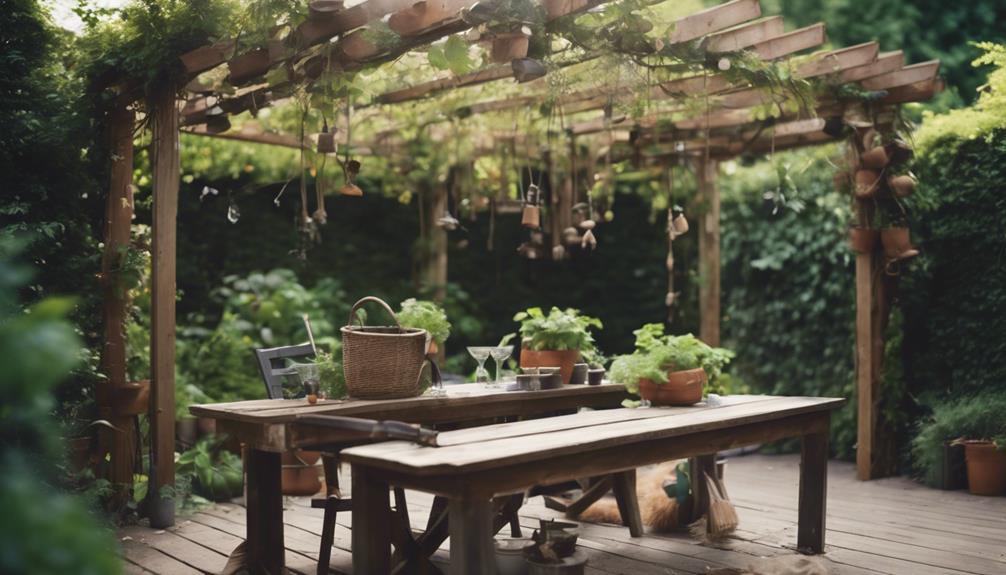
As we start building our dream pergola, selecting the right materials is essential for achieving the desired look and functionality. We need to choose materials that fit our budget, climate, and personal style.
When deciding on materials, we've several options to ponder. For a traditional look, we might choose wood, which can cost between $2,000-$5,000, depending on the type of wood.
Vinyl is another option, offering low maintenance and resistance to decay and insects, with a price range of $3,000-$5,000. Aluminum pergolas are durable and require minimal upkeep, costing between $3,000-$6,000.
If we're looking for a modern aesthetic, composite materials might be the way to go. Additionally, we could opt for fiberglass, which offers a sleek finish and comes with a higher price tag of $4,000-$8,000.
Pergola Location and Placement
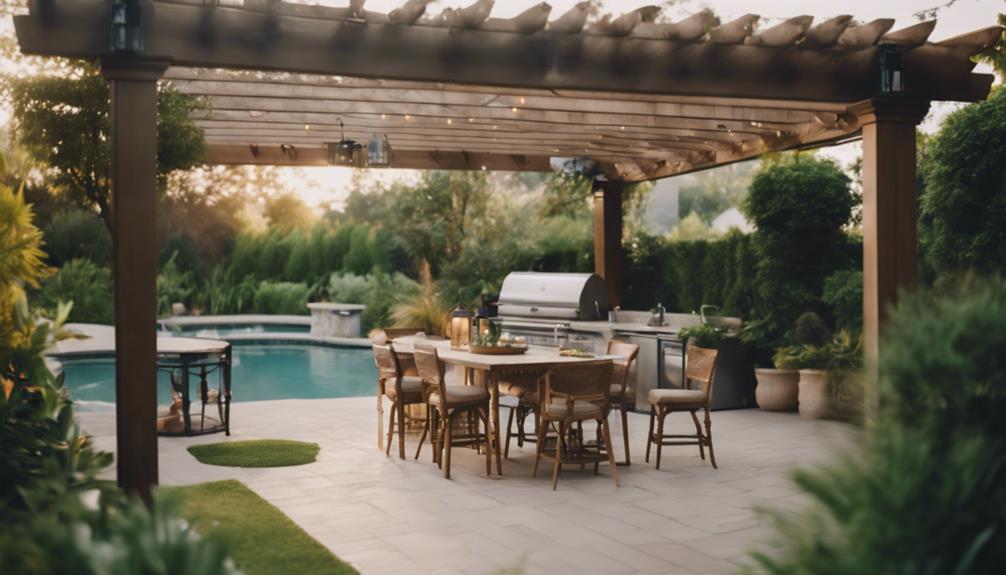
We must carefully ponder the location and placement of our pergola to guarantee it serves its intended purpose and complements our outdoor space. When selecting the right location, we need to take into account factors such as the sun's path and wind direction in our backyard. This ensures our pergola receives the right amount of sunlight and remains stable.
We should also assess the area in our yard to determine the ideal placement, taking into account our goals for the pergola, such as extending living space or providing shade. Proper placement can enhance our outdoor space and create a comfortable and inviting area for relaxation or entertainment.
To guarantee stability, we should take precise measurements using tools like StruXures PergolaX and Professional Building Services. By doing so, we can identify the perfect size and location for our pergola, aligning with our architectural features and overall aesthetic.
Designing for Functionality

Designing a pergola that serves its purpose requires careful consideration of its intended use, whether we're creating an intimate dining area, a lounging oasis, or an entertainment hub. As we plan our pergola, we need to think about how we'll be using the space. Will we be hosting outdoor dining parties or relaxing with a good book? This will help us choose the right materials, accessories, and features to make our pergola a functional addition to our outdoor space.
| Intended Use | Key Features | Benefits |
|---|---|---|
| Outdoor Dining | Tables, benches, lighting | Protection from the elements, comfortable seating |
| Lounging Oasis | Soft seating, shade, greenery | Relaxing atmosphere, connection to nature |
| Entertainment Hub | Sound system, bar, seating | Fun, social atmosphere, extended living space |
| Intimate Gathering | Fire pit, seating, greenery | Cozy atmosphere, connection to nature |
| General Use | Adjustable louvers, screens, seating | Versatility, protection from elements |
Selecting the Perfect Plants

By considering our climate, sunlight, and soil type, we can handpick the perfect plants to thrive in our pergola, ensuring a lush and inviting atmosphere.
When selecting plants for our pergola remodel, we should prioritize low-maintenance options that fit our care preferences. This way, we can enjoy the beauty of our outdoor space without breaking a sweat.
By choosing plants that align with our care habits, we're more likely to nurture them properly, ensuring their health and vigor. The right plants can greatly impact the aesthetics and maintenance of our pergola area.
We should select plants that thrive in our local climate and soil type, reducing the need for excessive watering or pruning. By doing so, we'll create an outdoor oasis that's both beautiful and easy to maintain.
With our selected plants, we can sit back, relax, and enjoy the fruits of our labor. By making informed plant choices, we'll be well on our way to creating a stunning pergola that's perfect for relaxation and entertainment.
Outdoor Lighting Essentials

A well-lit pergola can be transformed into an enchanting retreat, perfect for evening gatherings or romantic dinners, with the strategic placement of outdoor lighting. We've found that outdoor lighting enhances the ambiance and usability of pergolas, making them perfect for nighttime use. To create a warm atmosphere, we recommend using layered lighting, which creates different moods and atmospheres in the outdoor space.
| Lighting Type | Benefits | Placement Ideas |
|---|---|---|
| Solar-Powered Lights | Eco-friendly, energy-efficient | Along walkways, stairs, or around seating areas |
| String Lights | Creates a warm, cozy ambiance | Wrapped around beams or draped across the pergola |
| Spotlights | Highlights key features of the pergola design | Focused on architectural details or plants |
| Pathway Lights | Guides guests through the outdoor space | Along pathways, stairs, or around seating areas |
Pergola Installation Checklist
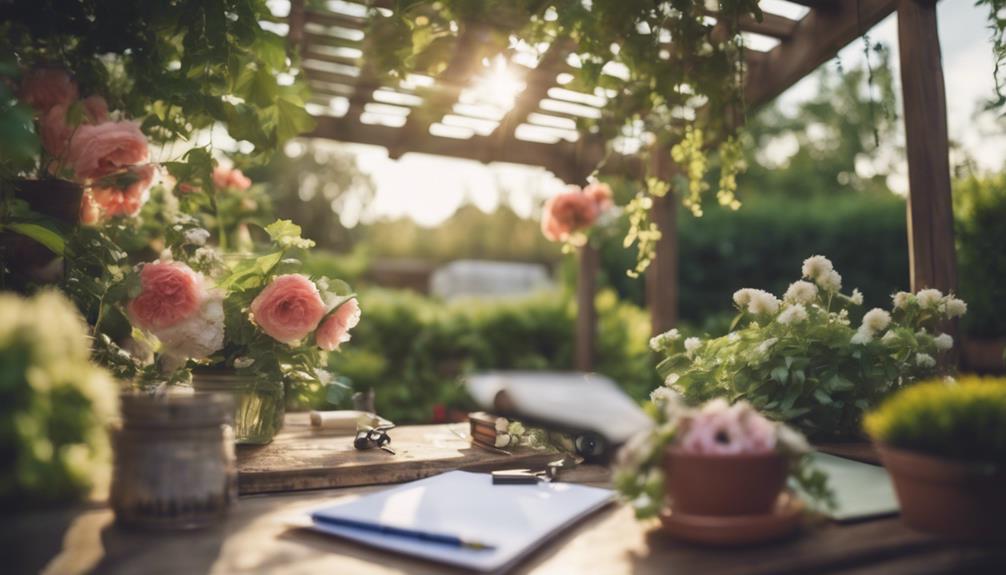
We've set the ambiance with outdoor lighting, and now we're ready to tackle the nuts and bolts of bringing our pergola to life, starting with a thorough installation checklist.
Before we begin, we'll need to verify local building regulations and obtain the necessary permits to avoid any delays or complications. It's also crucial to confirm compliance with zoning codes to guarantee a smooth installation process.
Next, we'll prepare the site by clearing vegetation, marking the pergola perimeter, and using concrete footings or anchors for stability. Then, we'll construct the pergola by securely installing posts, attaching support beams and rafters, and following design plans for proper assembly.
As we build, we'll add decorative elements to enhance the beauty and functionality of our pergola. By following this checklist, we'll be able to enjoy our new outdoor space in no time.
With careful planning and execution, our pergola installation will be a success, and we'll be able to relax and enjoy the fruits of our labor.
Maintaining Your Pergola
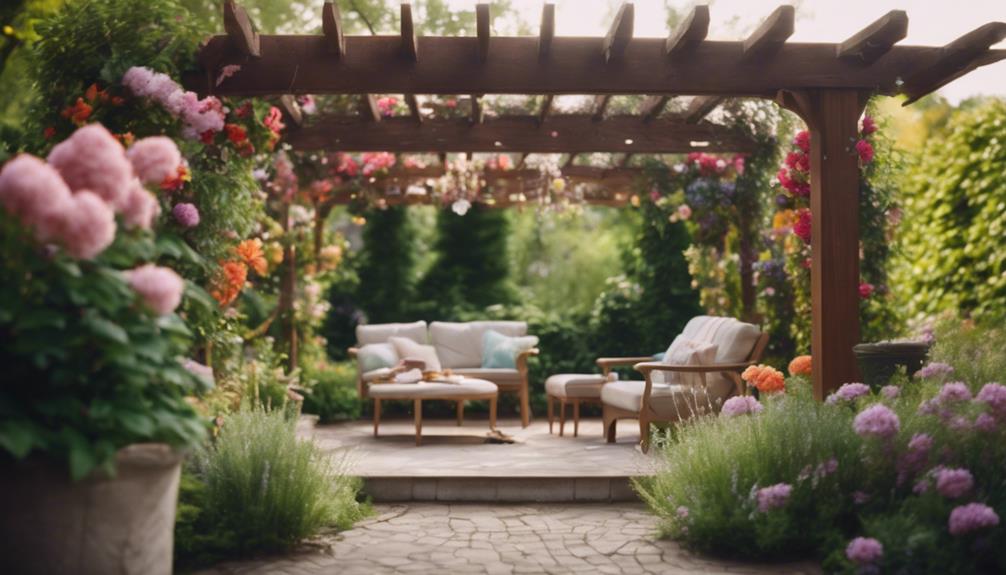
Now that our pergola is built, let's focus on preserving its beauty and structural integrity through regular maintenance. We understand that maintenance requirements can be overwhelming, but trust us, it's worth the effort.
To start, we clean our pergola structure with a mild soap solution to remove dirt and debris. We also make it a habit to tighten any loose hardware or connections to guarantee stability and safety.
Every 2-3 years, we apply a fresh coat of paint or stain to protect the wood from weather damage. Additionally, we trim back any overgrown vines or plants to prevent damage and maintain the pergola's structural integrity.
Finally, we inspect our pergola regularly for signs of rot, mold, or pest infestations, and address them promptly to prevent further damage. By following these simple steps, we can enjoy our pergola for years to come.
Frequently Asked Questions
What Is the Golden Ratio for a Pergola?
When designing a pergola, we aim for a visually pleasing structure. The golden ratio comes into play here.
We follow a 1:1.6:2.6 ratio for the width, height, and depth, creating a balanced and harmonious design. This timeless principle guarantees our pergola's proportions are optimized for aesthetic appeal and symmetry.
How Do I Make My Pergola Look Pretty?
We want our pergola to look pretty, and we're not alone! To achieve that, we incorporate climbing plants like wisteria or jasmine for a natural touch.
We add string lights or lanterns for a cozy ambiance in the evenings.
Hanging curtains or outdoor fabric panels add color and texture.
Does a Pergola Add Value to Property?
We've got a question on our minds: does a pergola add value to our property?
The answer is a resounding yes! A well-designed pergola can increase our property value by up to 20%. It's an attractive feature that enhances curb appeal, creating an appealing outdoor living space that potential buyers love.
Quality construction and design can greatly boost our property's value, making it more desirable to buyers and increasing its resale value.
What Is the Best Wood for an Outdoor Pergola?
As we step into the great outdoors, we crave a haven that's both beautiful and durable.
When it comes to choosing the best wood for an outdoor pergola, we're spoiled for choice. Cedar, with its natural resistance to decay and insects, is a top contender.
Redwood, with its striking appearance, is another strong option.
If budget is a concern, pressure-treated pine or Douglas fir can provide a sturdy solution.
Conclusion
As we reflect on our pergola remodeling journey, it's amazing how a simple coincidence – stumbling upon an old gardening book – sparked a passion project that transformed our backyard oasis.
From planning to installation, we've covered it all. By following these guidelines, you'll create a stunning pergola that's both functional and beautiful.
Remember, with careful planning and attention to detail, your outdoor space can become a serene retreat that brings joy for years to come.
- About the Author
- Latest Posts
Introducing Ron, the home decor aficionado at ByRetreat, whose passion for creating beautiful and inviting spaces is at the heart of his work. With his deep knowledge of home decor and his innate sense of style, Ron brings a wealth of expertise and a keen eye for detail to the ByRetreat team.
Ron’s love for home decor goes beyond aesthetics; he understands that our surroundings play a significant role in our overall well-being and productivity. With this in mind, Ron is dedicated to transforming remote workspaces into havens of comfort, functionality, and beauty.
Decor
Vintage Mid Century Modern Plant Stand
Yearning for a blast from the past, discover the essence of retro style with vintage mid century modern plant stands that exude nostalgia and sophistication.

We're drawn to vintage mid century modern plant stands because of their sleek, minimalist designs, often featuring hairpin legs and geometric shapes that evoke an atomic-inspired aesthetic. These stands typically boast clean lines, showcasing a blend of functionality and style. While some are handcrafted, offering unique, one-of-a-kind pieces, others are mass-produced, providing an affordable option. When choosing a stand, consider the size, weight capacity, and material durability, ensuring it complements your existing decor. By exploring these factors, you'll find the perfect stand to infuse your space with nostalgia and sophistication. As we explore further, we'll uncover more nuances of these retro-inspired gems.
Key Takeaways
• Vintage Mid Century Modern plant stands often feature sleek lines, minimalist designs, and geometric shapes.
• Look for unique, handcrafted pieces with attention to detail, showcasing artisanal skills.
• Consider mass-produced options for affordability and consistency in design and quality.
• Choose a stand that complements your existing room decor and has the right size and weight capacity.
• Add a touch of nostalgia and sophistication with a vintage-inspired plant stand that infuses your space with retro flair.
Design Elements and Features
In addition to exploring the design elements and features of vintage mid-century modern plant stands, we're struck by the prevalence of sleek, clean lines and minimalist designs that epitomize the era's aesthetic.
These plant stands often incorporate hairpin legs, geometric shapes, and atomic-inspired motifs, which contribute to their retro charm. The use of materials like metal, wood, and wire is also characteristic of vintage mid-century modern plant stand construction.
We notice that some plant stands from this era may exhibit Scandinavian or Danish design influences, adding a touch of Nordic flair to their overall design. Moreover, retro color palettes, such as teak, brass, and avocado green, are prevalent in vintage mid-century modern plant stand designs, evoking a sense of nostalgia and retro appeal.
These design elements and features work together to create a distinctive visual language that's quintessentially mid-century modern. By understanding these design elements, we can appreciate the unique characteristics that make vintage mid-century modern plant stands so iconic and desirable.
Popular Styles and Materials

We turn our attention to the popular styles and materials that define vintage mid-century modern plant stands. Sleek lines, geometric shapes, and minimalist designs come together in a harmonious blend of form and function. These plant stands often showcase unique craftsmanship and iconic design elements from the 1950s and 1960s, reflecting the era's focus on simplicity and functionality.
Common materials used in vintage mid-century plant stands include wood, metal, and wire, which provide a sturdy base for showcasing small or large plants. The retro charm of these plant stands lies in their ability to blend seamlessly into modern home decor, adding a touch of nostalgia to any room.
As collectors and enthusiasts, we appreciate the timeless appeal of vintage mid-century modern plant stands, which exude a sense of minimalist sophistication. Whether made from wood, metal, or a combination of materials, these plant stands embody the essence of mid-century modern design, characterized by clean lines, geometric shapes, and a focus on functionality.
Handcrafted Vs Mass-Produced

We explore the dichotomy of handcrafted and mass-produced mid-century modern plant stands, highlighting the distinct characteristics that set them apart.
Handcrafted plant stands are truly unique and one-of-a-kind, showcasing artisanal skills and attention to detail. Each piece is carefully crafted, often with slight variations in design, adding to their charm and individuality. However, this labor-intensive process comes at a cost, making handcrafted plant stands more expensive.
On the other hand, mass-produced plant stands are often more affordable and readily available in larger quantities. Factory-produced using standardized processes, they guarantee consistency in design and quality. While they may lack the individuality of handcrafted pieces, they offer an affordable option for those who want to incorporate mid-century modern style into their decor.
Ultimately, the choice between handcrafted and mass-produced plant stands depends on personal preference and budget. If you're looking for a truly unique piece with artisanal flair, handcrafted may be the way to go. But if you're on a tighter budget, mass-produced options can still provide a stylish and affordable solution.
Decorating With Vintage Flair
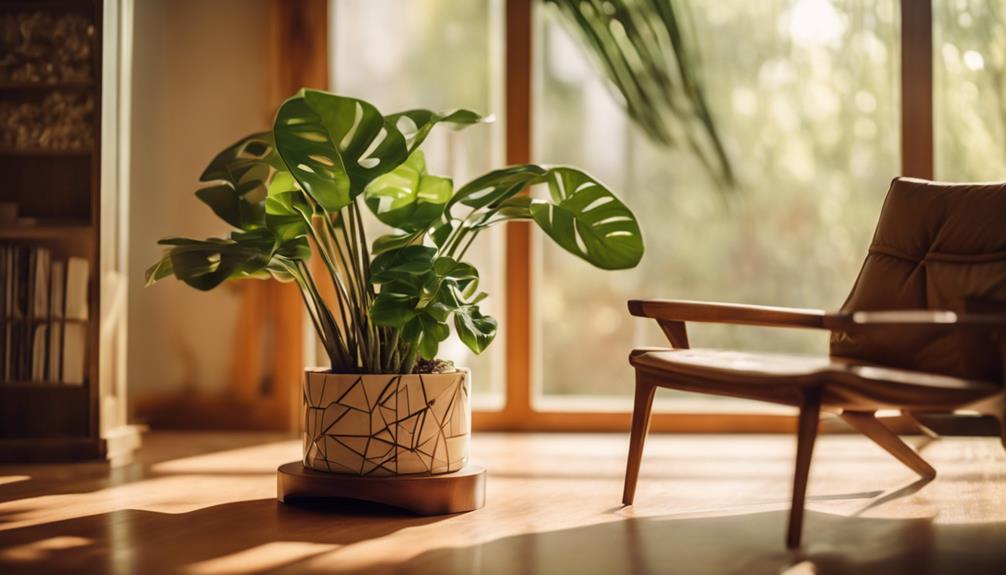
We're drawn to vintage mid-century modern plant stands because they infuse our spaces with a unique blend of nostalgia and sophistication. These retro pieces add a touch of flair to any room, and their distinctive designs from the 1950s and 1960s make them a standout decorative element.
| Style | Era | Characteristics |
|---|---|---|
| Rockabilly | 1950s | Bold, colorful, and eclectic |
| German | 1960s | Colorful, geometric patterns, and minimalist |
| Mid-Century Modern | 1950s-60s | Simple, organic shapes, and an emphasis on function |
| Retro | 1950s-60s | Playful, ornate, and nostalgic |
| Minimalist | 1960s | Simple, clean lines, and an emphasis on negative space |
When decorating with vintage flair, it's essential to consider the overall aesthetic you want to achieve. By incorporating a vintage plant stand into your decor, you can add a touch of sophistication and whimsy to any room. Whether you're drawn to the bold, colorful style of rockabilly or the sleek, minimalist design of German plant stands, there's a vintage mid-century modern plant stand to suit your unique taste.
Choosing the Right Stand

As we search for the perfect vintage mid-century modern plant stand, selecting the right one involves more than just falling in love with its retro charm. We need to take into account the size and weight capacity of the stand to make sure it can support our plants. A sturdy stand with durable materials like wood or metal is crucial for longevity. The design should complement our existing room decor, so we should pick a stand that enhances the aesthetic of our space.
We must also examine the dimensions of the plant stand to make sure it fits in the desired location. Opting for a vintage mid-century modern plant stand with unique features can add character to our room. For instance, a stand with a geometric pattern or a bold color can be a great conversation starter.
Frequently Asked Questions
Can Vintage Plant Stands Be Refinished or Repurposed?
We've wondered, can vintage plant stands be refinished or repurposed? The answer is yes! With some TLC, these antique pieces can regain their former glory. Sanding, staining, and polishing can revitalize worn wood, while a fresh coat of paint can modernize metal frames.
Repurposing ideas abound, from turning planters into unique coffee tables to transforming them into quirky bookshelves. With a little creativity, vintage plant stands can be reborn, blending nostalgic charm with modern functionality.
How Do I Clean and Maintain My Vintage Plant Stand?
Recognizing the importance of maintaining our beloved vintage plant stands, we take care to clean them gently.
To keep them looking their best, we lightly dust with a soft-bristled brush or a dry cloth.
For tougher dirt or grime, we prepare a mixture of mild soap and warm water, which we then apply with a soft cloth before wiping clean.
Regularly applying a gentle wood wax or oil also helps to preserve the finish.
Are Vintage Plant Stands Still Sturdy and Durable?
As we explore the world of plant stands, a pressing question arises: are vintage plant stands still sturdy and durable?
The answer lies in their construction. Many vintage plant stands were built with quality materials, such as solid wood or wrought iron, ensuring their durability. With proper care, these stands can withstand the test of time.
In fact, some vintage plant stands can last for decades with minimal maintenance.
Can I Use a Vintage Plant Stand Outdoors or in a Humid Space?
When considering outdoor or humid space use, we need to assess the material and construction of the plant stand. If it's made of metal, rust-resistant coating or galvanization is essential. Wooden stands require waterproofing or a durable finish to withstand moisture.
We should also confirm the stand's stability on uneven or slippery surfaces. If our stand meets these conditions, we can confidently use it outdoors or in humid areas, but regular maintenance is still necessary to prolong its lifespan.
Are Vintage Plant Stands a Good Investment or Just a Trend?
We often wonder if vintage items are a worthwhile investment or just a fleeting trend.
In general, antiques and vintage pieces can appreciate in value over time, making them a solid investment. However, their value is heavily dependent on factors like condition, rarity, and demand.
If we're talking about high-quality, unique, or limited-edition items, they can increase in value. But if it's a mass-produced or common item, its value may stagnate or even decrease.
Conclusion
As we weave through the world of vintage mid-century modern plant stands, we find ourselves in a lush forest of design, where functionality and aesthetics entwine like the tender shoots of a well-tended plant.
Like a master gardener, we've pruned away misconceptions, revealing the beauty of handcrafted and mass-produced pieces, popular styles, and materials.
Now, armed with the knowledge of how to choose the perfect stand, we can cultivate our own vintage oasis, where plants thrive and style flourishes.
- About the Author
- Latest Posts
Introducing Ron, the home decor aficionado at ByRetreat, whose passion for creating beautiful and inviting spaces is at the heart of his work. With his deep knowledge of home decor and his innate sense of style, Ron brings a wealth of expertise and a keen eye for detail to the ByRetreat team.
Ron’s love for home decor goes beyond aesthetics; he understands that our surroundings play a significant role in our overall well-being and productivity. With this in mind, Ron is dedicated to transforming remote workspaces into havens of comfort, functionality, and beauty.
-

 Vetted7 days ago
Vetted7 days ago15 Best Printers of 2024: Top Picks and Expert Reviews
-

 Vetted1 week ago
Vetted1 week ago15 Best Tile Sealers for Long-Lasting Protection and Shine
-

 Vetted2 weeks ago
Vetted2 weeks ago15 Best Smelling Floor Cleaners That Will Leave Your Home Fresh and Inviting
-

 Vetted15 hours ago
Vetted15 hours ago14 Best Lawn Tractors of 2024 – Ultimate Guide for Your Yard Maintenance
-

 Vetted2 weeks ago
Vetted2 weeks ago14 Best Power Scrubbers for Showers That Will Transform Your Cleaning Routine
-

 Vetted4 days ago
Vetted4 days ago15 Best Evergreen Plants for Shade Gardens: A Complete Guide
-

 Vetted4 days ago
Vetted4 days ago15 Best LED Dimmer Switches With No Flicker: Ultimate Guide for a Flicker-Free Lighting Experience
-

 Mardi Gras Decoration6 days ago
Mardi Gras Decoration6 days agoWhat Do the Symbols of Mardi Gras Mean?




